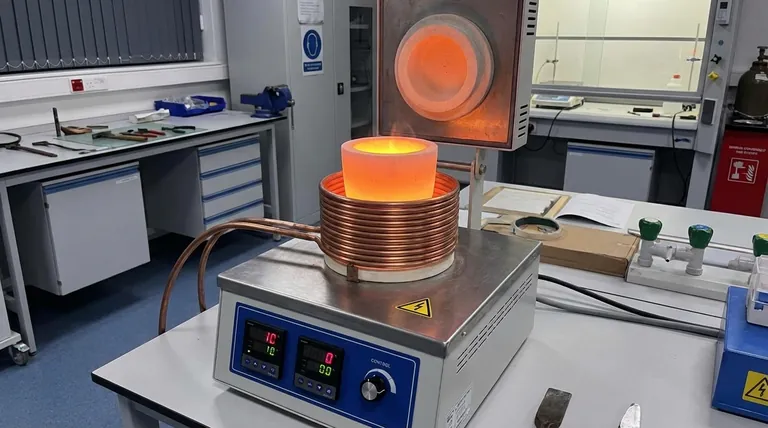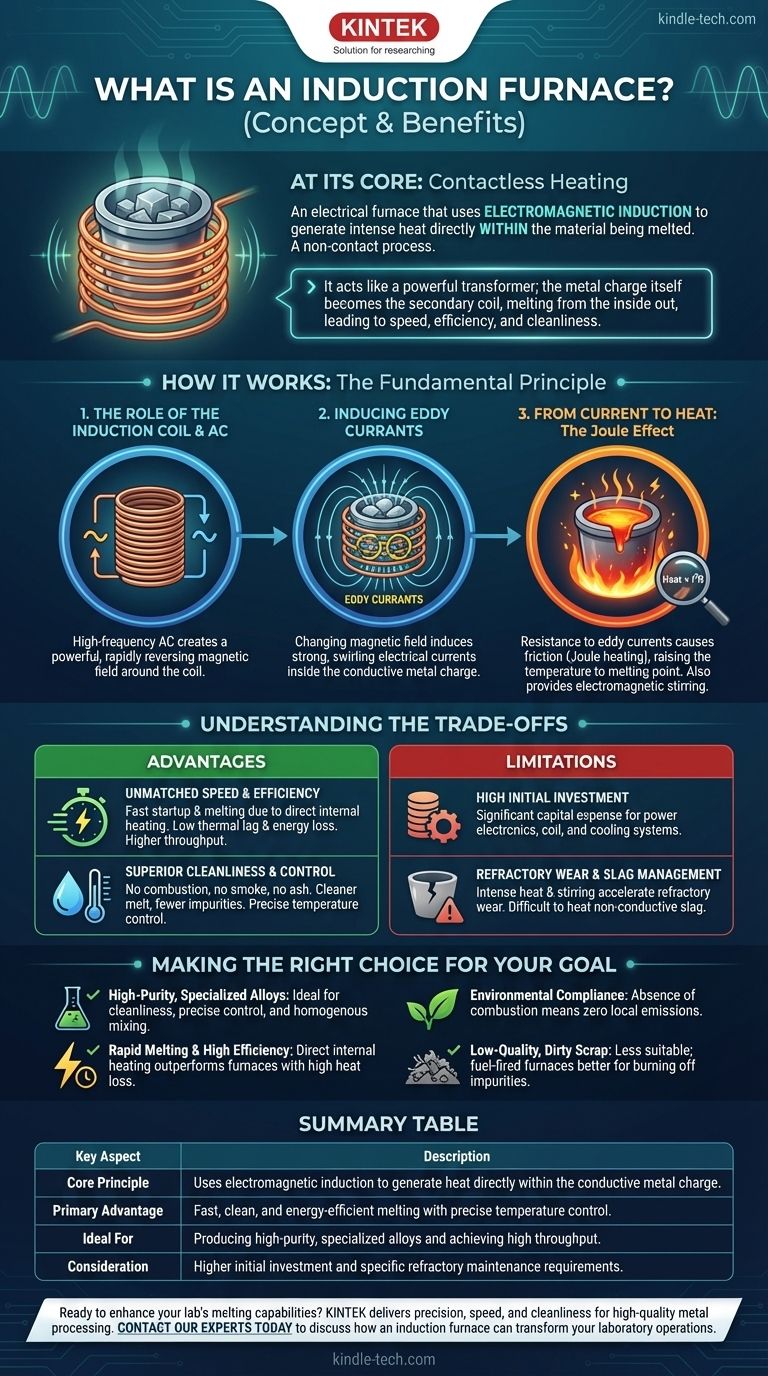At its core, an induction furnace is an electrical furnace that uses the principles of electromagnetic induction to generate intense heat directly within the material being melted. Unlike traditional furnaces that burn fuel or use external heating elements, an induction furnace acts like a powerful transformer where the metal charge itself becomes the secondary coil, melting itself from the inside out.
The crucial concept to grasp is that induction heating is a non-contact process. It leverages a changing magnetic field to create electrical currents inside a conductive material, and the material's own resistance to these currents generates the heat required for melting. This internal heating method is the source of its primary advantages: speed, efficiency, and cleanliness.

The Fundamental Principle: How Induction Creates Heat
An induction furnace’s operation is a direct application of two fundamental physics principles: Faraday's Law of Induction and the Joule effect. It’s a clean and contained process that turns electricity into heat with remarkable efficiency.
The Role of the Induction Coil and AC
The process begins with a large, water-cooled copper coil. A high-frequency alternating current (AC) is passed through this coil, which serves as the furnace's primary winding.
According to electromagnetic theory, this alternating current creates a powerful and rapidly reversing magnetic field both inside and around the coil.
Inducing Eddy Currents in the Metal
A conductive material, such as scrap metal or ingots (known as the "charge"), is placed inside a crucible within the coil. The powerful, changing magnetic field passes through this metal.
This magnetic field induces strong, swirling electrical currents within the metal charge. These are known as eddy currents. The metal charge effectively becomes a short-circuited secondary coil of a transformer.
From Current to Heat: The Joule Effect
The induced eddy currents flow against the metal's inherent electrical resistance. This resistance causes immense friction for the moving electrons, which manifests as intense heat.
This phenomenon, known as Joule heating (or I²R heating), is what raises the metal's temperature to its melting point and beyond. Because the heat is generated within the metal, the melting process is extremely fast and efficient.
The Added Benefit: Electromagnetic Stirring
The same magnetic fields that induce the currents also exert a force (the Lorentz force) on the molten metal. This creates a natural, vigorous stirring action within the melt.
This electromagnetic stirring is a significant advantage, as it ensures the molten bath has a uniform temperature and a homogenous chemical composition when alloying elements are added.
Understanding the Trade-offs
While powerful, induction technology is not a universal solution. Its benefits come with specific operational considerations and limitations that must be understood to use it effectively.
Advantage: Unmatched Speed and Efficiency
Because heat is generated directly within the charge, there is very little thermal lag or energy loss. This results in much faster startup and melting times compared to fuel-fired furnaces, leading to higher throughput and lower energy consumption per ton of metal produced.
Advantage: Superior Cleanliness and Control
There is no combustion involved in induction melting. This means no byproducts like smoke, ash, or carbon emissions are introduced into the process. The result is a cleaner melt with fewer impurities, which is critical for producing high-quality alloys. Temperature can also be controlled with extreme precision by adjusting the power supply.
Limitation: High Initial Investment
The power electronics required to generate high-frequency AC, along with the precision-engineered copper coil and cooling systems, represent a significant capital expense. This can make induction furnaces more costly to install than some traditional alternatives.
Limitation: Refractory Wear and Slag Management
The intense heat and vigorous stirring action can cause accelerated wear on the refractory lining of the crucible, requiring regular maintenance and replacement. Furthermore, induction is poor at heating non-conductive materials. This means any slag floating on the surface of the melt remains relatively cool, making it more difficult to manage and remove compared to other furnace types.
Making the Right Choice for Your Goal
Selecting an induction furnace depends entirely on your operational priorities, from the quality of the final product to your environmental and efficiency targets.
- If your primary focus is producing high-purity, specialized alloys: The cleanliness, precise temperature control, and homogenous mixing of an induction furnace are indispensable.
- If your primary focus is rapid melting and high energy efficiency: The direct internal heating mechanism of induction offers a clear advantage over furnaces that lose significant heat to the environment.
- If your primary focus is environmental compliance: The absence of combustion makes induction a fundamentally cleaner technology with zero local emissions.
- If your primary focus is melting low-quality, dirty scrap: A fuel-fired or electric arc furnace may be more robust, as it can burn off impurities that an induction furnace cannot effectively heat or process.
Ultimately, understanding the concept of induction melting empowers you to choose a technology based not just on what it melts, but on the precision, purity, and efficiency your final product demands.
Summary Table:
| Key Aspect | Description |
|---|---|
| Core Principle | Uses electromagnetic induction to generate heat directly within the conductive metal charge. |
| Primary Advantage | Fast, clean, and energy-efficient melting with precise temperature control. |
| Ideal For | Producing high-purity, specialized alloys and achieving high throughput. |
| Consideration | Higher initial investment and specific refractory maintenance requirements. |
Ready to enhance your lab's melting capabilities?
An induction furnace from KINTEK delivers the precision, speed, and cleanliness required for high-quality metal processing. Our expertise in lab equipment ensures you get a solution tailored to your specific needs, whether you're focused on alloy development, energy efficiency, or environmental compliance.
Contact our experts today to discuss how an induction furnace can transform your laboratory operations.
Visual Guide

Related Products
- 1400℃ Laboratory Quartz Tube Furnace with Alumina Tube Tubular Furnace
- 1700℃ Laboratory Quartz Tube Furnace with Alumina Tube Tubular Furnace
- 1800℃ Muffle Oven Furnace for Laboratory
- Lab-Scale Vacuum Induction Melting Furnace
- Laboratory Muffle Oven Furnace Bottom Lifting Muffle Furnace
People Also Ask
- How does a tubular furnace work? A Guide to Controlled High-Temperature Processing
- How to clean a tube furnace? A Step-by-Step Guide for Safe and Effective Maintenance
- What are the advantages of a tube furnace? Achieve Superior Temperature Uniformity and Control
- What is a tube furnace used for? Achieve Precise, Controlled Thermal Processing
- What is a tubular furnace used for? Precision Heating for Material Synthesis & Analysis



















